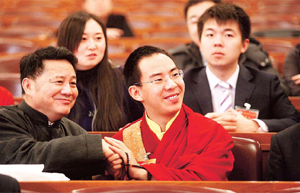Full text: Report on national economic, social development
(Xinhua)
Updated: 2010-03-16 14:14
3. We made new progress in restructuring.
We made headway in structural optimization and upgrading of key industries. We implemented in an orderly way the plan and related rules for restructuring and revitalizing ten major industries: the steel, motor vehicle, shipbuilding, petrochemicals, textile, nonferrous metals, equipment manufacturing, electronic information, logistics and light industries. To encourage quicker technological upgrading in enterprises, the central government allocated 20 billion yuan to support 4,441 technological upgrading projects. Substantial progress was made in mergers and reorganizations in the machinery, steel, nonferrous metals and papermaking industries. Three integrated refinery and petrochemical complexes, each with ten-million-ton oil refining capacity and one-million-ton ethylene production capacity, were completed and put into production, one each by Dushanzi Petrochemical Corporation, Xinjiang, Fujian Refinery and Petrochemical Company and Tianjin Petrochemical Corporation. We reversed the decline in high-tech manufacturing and achieved a year-on-year increase of 7.7%. We issued and implemented industrial policies for digital television and biological industries. We launched major projects to promote the industrial application and development of technologies in the areas of satellite applications, biotechnology, integrated circuits, flat-panel displays and helicopters. The first Airbus A320 aircraft produced by Airbus Final Assembly Line China in Tianjin made a successful maiden flight. We intensified efforts to build 3G networks with TD-SCDMA as the national standard and promote 3G businesses. Our work to domestically produce key equipment proceeded smoothly. We made a significant breakthrough in independently developing and manufacturing large forgings, a key component of nuclear power generators, and our capacity to domestically produce high-speed EMU trains and urban rail transit facilities improved significantly.
We steadily pressed ahead with the adjustment of industries with excess production capacity. We formulated and implemented the Guidelines on Curbing Excess Production Capacity and Redundant Development in Some Industries and Guiding Them toward Healthy Development, and put forward the main principles, policies and measures on promoting the healthy development of the steel, cement, plate glass and coal chemicals industries. A system for the joint release of information by government departments was set up, and guidance of industrial information was strengthened. We continued to improve the mechanism for eliminating backward production facilities. We put small-capacity thermal power generating units with a total capacity of 26.17 million kilowatts out of business last year, and reached the goal of eliminating small-capacity thermal power generating units with a total capacity of 50 million kilowatts within the Eleventh Five-Year Plan period (2006-2010), one and a half years ahead of schedule. In addition, we shut down backward production facilities in a number of industries, including steel mills with a total capacity of 16.91 million tons, iron foundries with a total capacity of 21.13 million tons, coalmines with a total capacity of 50 million tons, cement plants with a total capacity of 74.16 million tons, calcium carbide plants with a total capacity of 460,000 tons, ferrous alloy foundries with a total capacity of 1.62 million tons, coking works with a total capacity of 18.09 million tons, paper mills with a total capacity of 500,000 tons and chemical fiber mills with a total capacity of 1.37 million tons.
The pace of independent innovation was accelerated. We smoothly implemented the Outline of the National Program for Long- and Medium-Term Scientific and Technological Development (2006-2020). The central government spent 151.2 billion yuan on science and technology, an increase of 30%. Sixteen key science and technology programs, including the development of fabrication equipment and complete process technology for ultra-large scale integrated circuits, high-grade digitally controlled machine tools and basic manufacturing equipment, were fully implemented. Major science projects, such as those to develop the "large sky area multi-object fiber spectroscopic telescope" and upgrade the Beijing electron-positron collider, were successfully completed. Faster progress was made in the third phase of the Knowledge Innovation Program. Significant progress was made in the Technology Innovation Program, the March 1986 High-Tech Program, the March 1997 Program for Basic Research and other state science and technology programs. Twenty-five national engineering laboratories and 63 key national laboratories were built. Support was given to 58 national engineering or technology research centers to improve their capacity for sustained innovation. Eighty-five national projects to develop major industrial technologies were implemented. We assisted enterprises in improving their R&D and laboratory conditions.
Infrastructure and basic industries were constantly strengthened. We increased investment in the South-to-North water diversion project and other large and medium-sized water conservancy projects. Major railway projects, including Beijing-Shanghai, Harbin-Dalian, Shijiazhuang-Wuhan and Lanzhou-Urumqi railways, progressed smoothly. Construction of the national expressway network proceeded in an orderly manner. Construction began on the Hong Kong-Zhuhai-Macao Bridge. An additional 5,557 kilometers of railways and 98,000 kilometers of highways were opened to traffic, including 4,719 kilometers of expressways. A total of 35 civilian airports were built, upgraded or expanded. Work on building large, specialized, deepwater ports and on improving the main navigation channel on the Yangtze River was sped up. Construction began on the eastern section of the second West-to-East Natural Gas Pipeline Project, the Hulun Buir coal-fired power generation base and an energy and chemicals production base in Ningxia. The western section of the second West-to-East Natural Gas Pipeline Project was put into operation. Installed power-generating capacity was increased by 89.7 million kilowatts. We approved the construction of six one-gigawatt nuclear power generating units. Work on large hydropower projects, such as the Jishixia power station on the Yellow River in Qinghai Province and the pumped-storage power plant in Qingyuan, Guangdong Province, progressed smoothly. Construction of a ten-gigawatt wind power generation base, the first of its kind in China, was started in Jiuquan, Gansu Province. Upgrading of urban power grids progressed in an orderly manner. The second phase of the state petroleum reserves project was implemented. Annual coal output reached 3.05 billion tons, up 8.8% from the previous year, and 150 million tons more than planned; oil production hit 189 million tons, 3 million tons less than planned; and 3.7 trillion kilowatt-hours of electricity were generated, a rise of 6.3%, and 73.8 billion kilowatt-hours more than planned.
The service sector experienced steady growth. We further implemented policies and measures for encouraging service sector development. We gave greater support to modern services in terms of fiscal and tax, land supply, pricing and financial policies. We successfully launched a number of major interregional, cross-sector projects that will play a stimulating and supporting role for service industries. Banking, insurance, information services, logistics and community services grew rapidly, and a variety of new business emerged in the service sector. The value-added of tertiary industry accounted for 42.6% of GDP, 0.8 percentage points higher than the year before.


